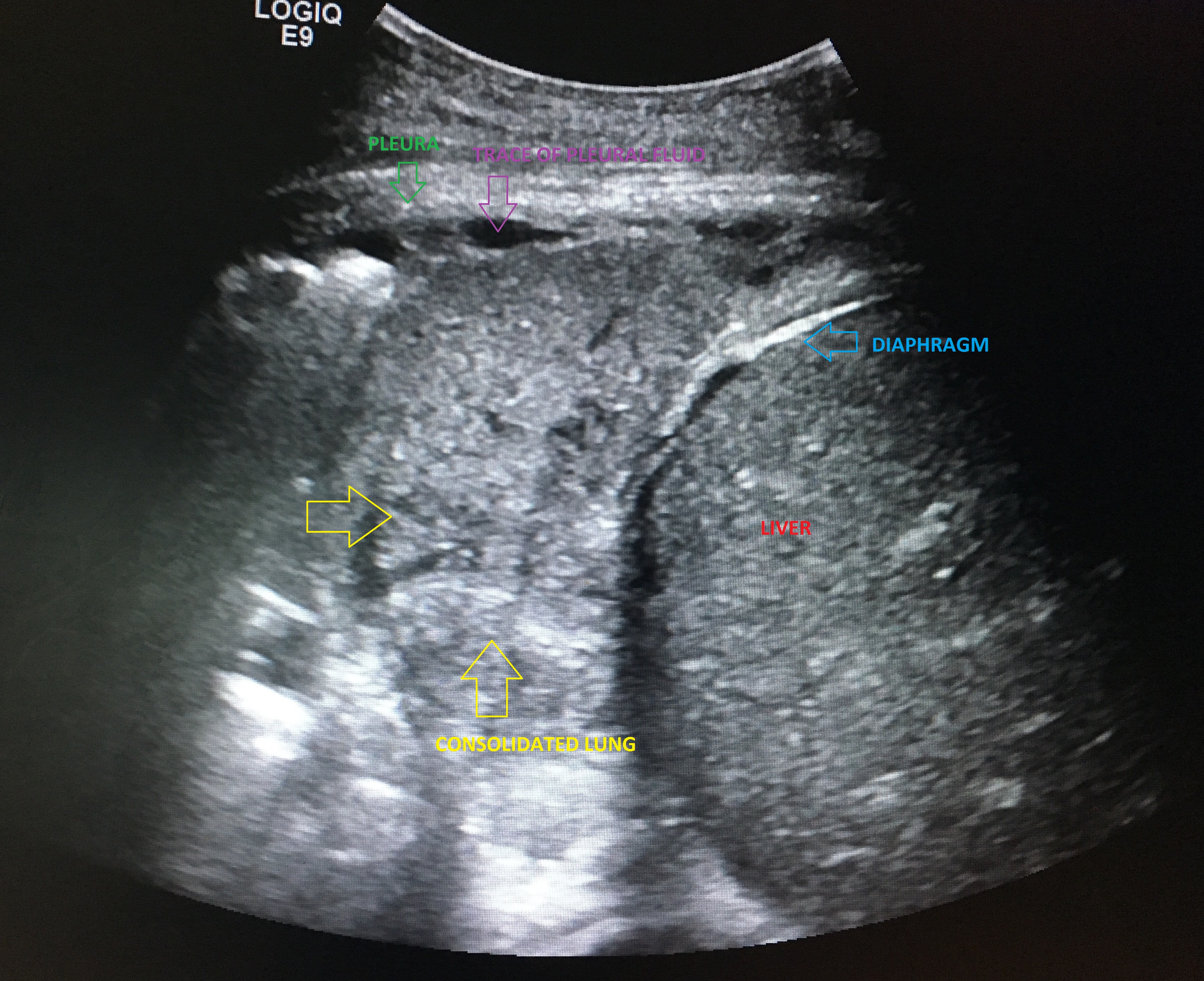Bacterial pneumonia other imaging findings: Difference between revisions
No edit summary |
|||
| Line 9: | Line 9: | ||
Ultrasonography is very useful in assessing the pleural fluid including its amount, viscosity and loculations as well as pulmonary septations. It can be helpful in cases of complex pleural collections. Results of ultrasonography rely upon the homogeneity, shape, marginal characteristics as well as presence or absence of air bronchograms. Pneumonia progresses to hepatization in which it appears ''liver-like'' on imaging, with the exception of branching structures naturally present within the lungs.<ref name="Radiopedia">{{cite web|url=https://radiopaedia.org/cases/pneumonia-ultrasound-1}} </ref> | Ultrasonography is very useful in assessing the pleural fluid including its amount, viscosity and loculations as well as pulmonary septations. It can be helpful in cases of complex pleural collections. Results of ultrasonography rely upon the homogeneity, shape, marginal characteristics as well as presence or absence of air bronchograms. Pneumonia progresses to hepatization in which it appears ''liver-like'' on imaging, with the exception of branching structures naturally present within the lungs.<ref name="Radiopedia">{{cite web|url=https://radiopaedia.org/cases/pneumonia-ultrasound-1}} </ref> | ||
[[Image:Lung-consolidation-on-ultrasound.jpeg|300x300px|Lung consolidation on ultrasound - Case courtesy of Dr Ian Bickle, [https://radiopaedia.org/cases/lung-consolidation-on-ultrasound Radiopaedia.org], rID: 59328|alt=|thumb|none]] | [[Image:Lung-consolidation-on-ultrasound.jpeg|300x300px|Lung consolidation on ultrasound - Case courtesy of Dr Ian Bickle, [https://radiopaedia.org/cases/lung-consolidation-on-ultrasound Radiopaedia.org], rID: 59328|alt=|thumb|none]][[Video:Pneumonia-ultrasound-1.mp4|frame|thumb|centre|500px|Pneumonia ultrasound - Case courtesy of Dr David Carroll, Radiopaedia.org, rID: 62410]] | ||
=MRI of the chest= | =MRI of the chest= | ||
Revision as of 09:21, 11 January 2022
|
Bacterial pneumonia Microchapters |
|
Diagnosis |
|
Treatment |
|
Case Studies |
|
Bacterial pneumonia other imaging findings On the Web |
|
American Roentgen Ray Society Images of Bacterial pneumonia other imaging findings |
|
Risk calculators and risk factors for Bacterial pneumonia other imaging findings |
Editor-In-Chief: C. Michael Gibson, M.S., M.D. [1]; Associate Editor(s)-in-Chief: Arooj Naz
Overview
Bacterial pneumonia is primarily diagnosed with chest x-ray and CT scan in certain cases. Other diagnostic tests are available but are frequently not utilized compared to the aforementioned two modalities. These include ultrasonography, chest MRI, and needle biopsy of the affected lung.[1] Bronchopsy may also be used to diagnose pneumonia.
Lung Ultrasound
Ultrasonography is very useful in assessing the pleural fluid including its amount, viscosity and loculations as well as pulmonary septations. It can be helpful in cases of complex pleural collections. Results of ultrasonography rely upon the homogeneity, shape, marginal characteristics as well as presence or absence of air bronchograms. Pneumonia progresses to hepatization in which it appears liver-like on imaging, with the exception of branching structures naturally present within the lungs.[2]

MRI of the chest
MRI is not a commonly utilized method of imaging for pneumonia but it may be helpful in evaluating the heart, vessels, and surrounding chest structures. Patients affected with pneumonia often present with shortness of breath and have difficulty holding their breath for long periods of time. Due to the fast imaging technique provided by MRI, this can be helpful for such patients. MRI can also help in reducing radiation exposure. IT is important to note that calcifications and air pockets within lesions are not easily visualized using MRI.[3]
Needle Biopsy of Lung
Bronchopsy
References
- ↑ https://www.radiologyinfo.org/en/info/pneumonia. Missing or empty
|title=(help) - ↑ https://radiopaedia.org/cases/pneumonia-ultrasound-1. Missing or empty
|title=(help) - ↑ Eibel R, Herzog P, Dietrich O, Rieger C, Ostermann H, Reiser M; et al. (2006). "[Magnetic resonance imaging in the evaluation of pneumonia]". Radiologe. 46 (4): 267–70, 272–4. doi:10.1007/s00117-005-1326-7. PMID 16395604.